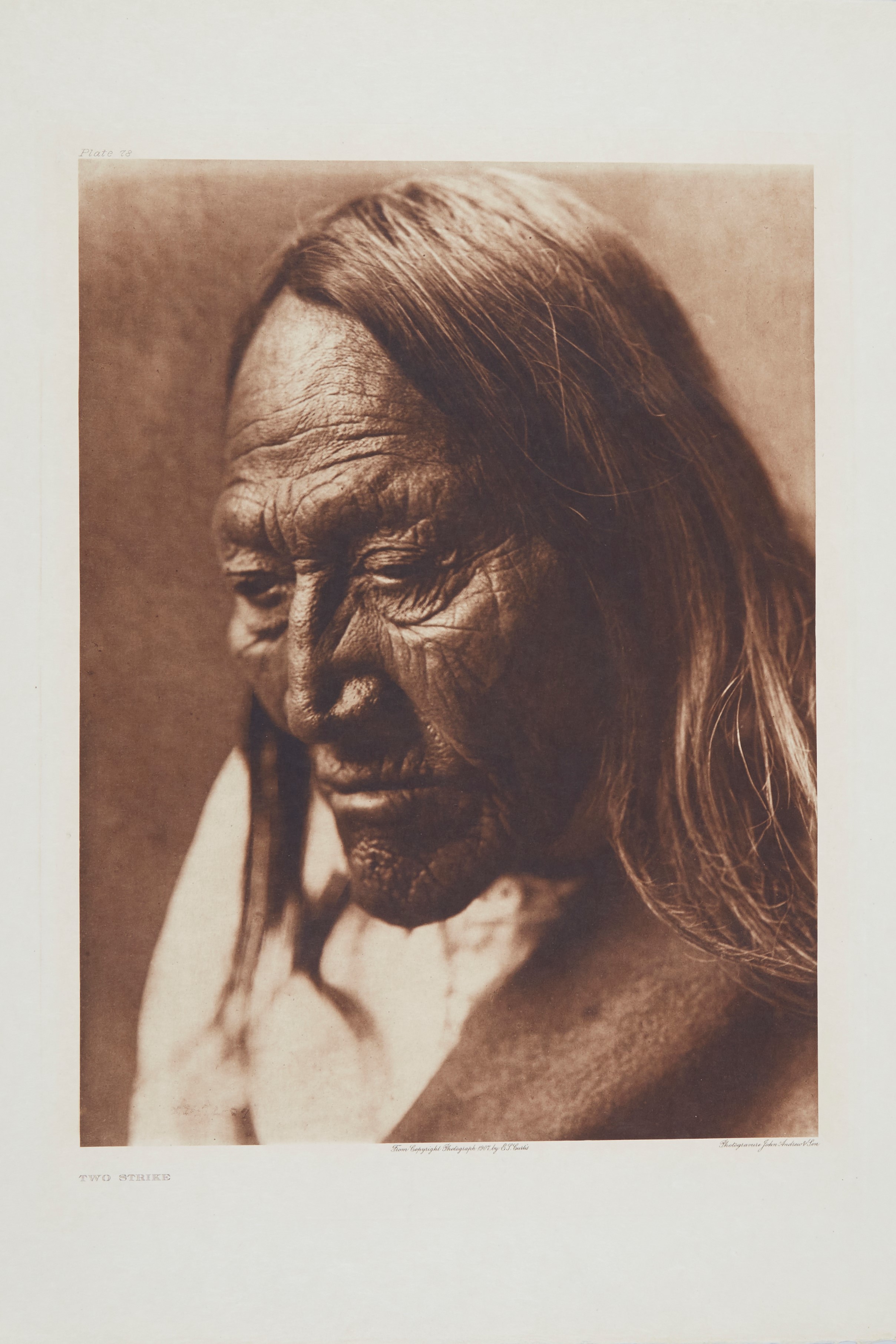Earlier this year, we had the privilege of framing an Edward Curtis photogravure, Two Strike. Coincidentally, at the same time The Conservation Center was working on the piece, another photogravure of Two Strike was being featured in the Muskegon Museum of Art’s exhibition Edward S. Curtis: The North American Indian. Described as “an event of national significance celebrating the artistic genius and lasting cultural legacy of Edward Curtis,” the exhibition covers the work of a man “who sacrificed everything for his art, died in obscurity, but left behind one of the greatest artistic collaborations and photographed achievements in history.”
A beautiful photogravure, Two Strike demonstrates one of 723 photographs of Native Americans on display at MMA by Edward Curtis. Often called “Shadow Catcher” by various Native American tribes, Curtis captured over 40,000 images from over 80 tribes. In addition to photographs, Curtis produced ten thousand wax cylinder recordings of Native American languages and captured the first film footage of American Indians.
In total, The North American Indian project included over 2,200 of Curtis’s photographs and thousands of pages of anthropological research, organized into twenty volumes accompanied by bound portfolios of oversize gravures. This project of over 25 years in the making wouldn’t have been possible without the financial support and encouragement of influential figures such as Theodore Roosevelt, J.P. Morgan, and members of European royalty. In fact, the total cost for a project of this magnitude and quality in today’s standards would exceed 35 million dollars. The depth and extent of Curtis’s work is truly a feat for his time.
Two Strike, Photogravure by Edward Curtis
When our client brought Two Strike to The Center in November of 2016, we could not have been more thrilled to participate in the preservation of this important work. One staff member was particularly enthusiastic – Toby, the head of our custom framing department: “As someone who has long admired Curtis for his documentation of Native American culture and American history, I feel honored and responsible to guide the caretakers of Curtis’s works. If we do our job successfully, not only will we preserve and protect his artwork, but we can enhance its presentation while doing so.”
“As someone who has long admired Curtis for his documentation of Native American culture and American history, I feel honored and responsible to guide the caretakers of Curtis’s works. If we do our job successfully, not only will we preserve and protect his artwork, but we can enhance its presentation while doing so.”
Luckily, the photogravure was in great condition and simply required archival, conservation-grade framing. Since the edges of the photogravure were deckled (an appearance of uneven or rough edges as a result of the paper making process), our custom framing department suggested float mounting the piece. As Toby noted, “because the paper choices were so important to Curtis, we decided Two Strike would be best viewed floated as to expose the edges of the deckled paper.” The piece was then hinged with Japanese Kozo paper hinges and reversible wheat starch paste to an archival 4-ply mat, sympathetic to the photogravure.
In selecting a frame, our client opted for a custom dark padauk frame with beveled edges. The tonality of the wood beautifully showcases the photogravure, complementing areas of darkness and contrasting with areas of brightness. As Toby recalls, “we worked with the client to design something that was visually appealing while also preserving and protecting the piece.” The framing project was completed with the addition of Museum Glass, a conservation grade, anti-reflective glass that protects against UV light rays, and a Coroplast backing board for protection.
Two Strike, shown housed in a custom dark padauk frame
The need for custom framing, as in the case of the Curtis photogravure, is a common occurrence at The Center. While many of our clients are primarily concerned with stabilizing and addressing damages to works of art, the framing of Two Strike demonstrates that ensuring works are properly housed can also contribute to the long-term preservation and stabilization of artwork. By utilizing archival materials and UV protective glazing, works of art are protected from acidity, UV rays, and airborne contaminants that pose serious threats for the longevity of artwork.
Recognized as the largest artistic collaboration and photographic collection achievement in history, The North American Indian demonstrates the life’s work of Edward Curtis. Don’t miss Edward S. Curtis: The North American Indian on display at the Muskegon Museum of Art through September 11. We hope to see you there!
Sources:
http://www.muskegonartmuseum.org/edward-curtis-north-american-indian/
http://www.pbs.org/wnet/americanmasters/edward-curtis-shadow-catcher/568/
https://edwardcurtis.com/edward-curtis-biography/


